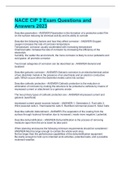NACE CIP 2 Exam Questions and
Answers 2023
Describe passivation - ANSWER-Passivation is the formation of a protective oxide Film
on the surface reducing its chemical activity and its ability to corrode
Describe the following factors and how they affect corrosion - ANSWER-Oxygen:
oxygen increases the rate of corrosion temperature
Temperature: corrosion usually accelerated with increasing temperature
Chemical salts: increase the rate of corrosion by increasing the efficiency of the
electrolyte
humidity: the wetter the environment, the more corrosion is likely to occur pollutants and
acid gases: all promote corrosion
Two broad categories of corrosion can be described as - ANSWER-General and
localized
Describe galvanic corrosion - ANSWER-Galvanic corrosion is an electrochemical action
of two dissimilar metals in the presence of an electrolyte and an electron conductive
path, Which occurs when the dissimilar metals come into contact
Describe cathodic protection - ANSWER-Cathodic protection is the reduction or
elimination of corrosion by making the structure to be protected a cathode by means of
impressed current or attachment to a galvanic anode
The two primary types of cathodic protection are - ANSWER-Impressed current and
galvanic (sacrificial)
impressed current power sources include: - ANSWER-1. Generators 2. Fuel cells 3.
Wind powered cells 4. Thermoelectric cells 5. Rectified commercial power 6. Solar Cells
Describe cathodic disbondment - ANSWER-The separation of the coating from the
surface through hydroxyl formation due to increased ( made more negative ) potential.
Describe dehumidification - ANSWER-Dehumidification is the process of removing
moisture vapor from the air to lower its dew point
When planning enclosures the following minimum requirements should be considered -
ANSWER-Must be large enough to contain the whole work area.
Not be larger than the performance capabilities of the dehumidification equipment.
Be sturdy enough to hold up to intended work activities, potential loads, and a possible
inclement weather.
,Have minimal leakage to maintain proper environmental conditions and ensure the
dehumidification system operates efficiently.
Describe air turns (air changes) - ANSWER-The air turnover principal illuminates air
stratification, or layering, in large open spaces by recirculating the hot air that becomes
trapped in the higher spaces.
The number of times it does this per hour is called air turns.
At & below what relative humidity does corrosion virtually cease - ANSWER-40%
Describe two ways to reduce the relative humidity of the boundary layer - ANSWER-
Increase the surface temperature and reduce moisture content by dehumidification
Types of dehumidification equipment include - ANSWER-Refrigeration and desiccant
Describe several benefits of dehumidification - ANSWER-Dries the air. Lowers the dew
point. Permits blasting the entire surface. Holds the blast with dry air. Helps in cleaning
the surface. Holds the surface during coating application.
Electronic hygrometers can be used to determine - ANSWER-Relative humidity, air
temperature, and dewpoint temperature.
Advanced environmental testing instruments have the ability to store data that can be
transferred to a computer and other devices. Transfer methods include - ANSWER-
USB, IR, Bluetooth
Some general basic centrifugal blast set ups include - ANSWER-Tumbling mill,
multitable, plain table, swing table, custom designed systems
Centrifugal blasting conveyor systems are commonly used for cleaning - ANSWER-
Plate, rolled structural shapes, large trusses, girders
Portable centrifugal blasting systems can be used on - ANSWER-Ship decks, hull sides,
and bottoms. Storage tanks. Concrete floors. Highways and bridge decks.
Generally centrifugal blast systems are composed of the following elements -
ANSWER-Centrifugal abrasive throwing wheel, the blast cabinet, in fixed systems some
type of material handling system, abrasive recycling system, a dust collector and vent
pipe system, abrasives.
The efficiency of the centrifugal blast wheels depends on several factors - ANSWER-
Abrasive operating mix, size of the abrasive, velocity of the abrasive coming off the
wheel, quantity and direction of the thrown abrasive, condition of the feed parts.
Little amperage readings on a centrifugal blasting machine could signify - ANSWER-An
abrasive starved wheel, a flooded or choked wheel
, The functions of the centrifugal blasting machine separator include - ANSWER-To
control the sizing of the abrasive mix, to remove sand, spent abrasives, rust, dirt, and
any other contaminants from the abrasive stream, to control abrasive consumption
A well balanced operating mix (working mix) of abrasives will - ANSWER-Provide
consistency of the finish, ensure uniform abrasive coverage, ensure conditioning of the
abrasive for optimum cleaning, minimize lowest abrasive and machine part where and
reduce downtime for maintenance
Some of the inspection concerns during centrifugal blasting include - ANSWER-Monitor
the dust collector, monitor the amperage of the wheel motors / low amperage, Monitor
the handling in the loading of the conveyor line for contaminants and possible
discontinuities in the steel, monitor the speed of wine, inspect the steel as it leaves the
production line
The WJ-1 (visual cleanliness) is comparable to which abrasive blast cleaning standard -
ANSWER-ISO SA 3
A general description of robotic water jetting includes - ANSWER-Attaches using
vacuum, cables, or magnets
Vertical, Horizontal or overhead surface
Controlled by single operator
Collects in excess 95% of the water, removed coatings and rust (waste generated)
A typical waterjetting team consist of - ANSWER-The nozzle operator, the pump
operator, additional operators or workers.
Waterjetting is effective for removing - ANSWER-Surface oil and grease, rust, concrete
(shot-crete) spatter, existing coatings, water soluble contaminants that cannot otherwise
be removed by abrasive blasting, an underwater unit used to clean barnacles or other
microorganisms for ships hulls or offshore platform legs.
Describe two of the considerations with regards to "back thrust" - ANSWER-Causes
fatigue and should 1/3 of operators body weight
To ensure safe workplace, before commencing the job, the waterjet team should ensure
that - ANSWER-The work area is properly barricaded.
Electrical equipment is protected from water.
Electrical connections are not allowed to sit in water.
All fittings and hoses are in good condition / proper pressure rating.
Nozzle is free of obstructions.
System is flushed clean and air removed.
The dump system and all control systems are operational.
Proper LOTO provisions / confined space entry requirements.




